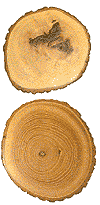 |


|


|
Introduction and Activities
The Earth is constantly changing. Weather and seasons are clear examples of regular changes in the global environment. Other changes are not as evident because they occur over intervals longer than a human lifetime or because the changes are not easily seen. Much of the change takes place on Earth is part of natural cycles. Human activity, however, can also cause environmental changes.
The following activities are presented to assist in teaching these concepts of Global Change. Please consult The Teacher's Guide which explains how the activities are related to time, change, cycles, and Earth as home. From there, you can check out the following activities:
Time and Cycles
Change and Cycles
Earth as Home
People are being asked to limit activities that change the environment, but before sensible limits can be adopted, we need information. Questions include:
- What are current environmental conditions and how are they changing?
- Are environmental changes caused by natural variation or by human activity, or both?
- How will local changes affect other parts of the Earth and its systems?
Scientists study global change to help answer these questions. The Earth is our home. We can take better care of our home when we better understand how it works and what changes it is undergoing. Before global change can be studied, we must be able to observe it. These images are evidence of Global Change.
|


|
Greenness Maps
Greenness maps are made by computer from information recorded by instruments on satellites. Areas where plants grow radiate more energy than barren areas do. These two maps show plant growth across the United States at the beginning of a growing season, in April 1992 (top) and at the peak of growth in June 1992 (bottom). The greenest areas on the image are areas of vigorous growth. Areas with no plant growth are in brown. Maps like these, made every 2 weeks during the growing season, record the effects of drought and other weather changes.
Click on the maps to get a larger view.
|

|
Brazilian Rain Forest Satellite Images
These satellite images from the Landsat program show the same area of the Brazilian rain forest in 1975 (left) and in 1986 (right). Forest vegetation is red and the roads and cleared areas with houses and farms are in blue. In 1975 there was little development along the roads. By 1986 many secondary roads had been built. Areas where the forest has been cut down for lumber or crops extend out from the secondary roads in blue feather-like patterns.
Click on the satellite images to get a larger view.
|

|
Keeling Chart
In 1958, American scientist Charles David Keeling began measuring the concentration of the gas carbon dioxide (CO2) in the atmosphere. This graph presents data gathered on Mauna Loa, a volcano 4,000 meters high in Hawaii. Two patterns can be seen. From 1958 to 1988, CO2 concentration increased by about 40 parts per million (ppm). The "sawtooth" pattern reflects a seasonal fluctuation in CO2 of about 5ppm. Plants draw carbon dioxide from the atmosphere to make food. Thus, in the Northern hemisphere CO2 concentration peaks in early spring just before plant growth begins and falls off in October when the growing season ends.
Click on the chart to get a larger view.
|


|

Tree Rings Images
Trees record climate change. Each year a tree forms a new layer of tissue. The width of each year's ring reflects growing conditions such as moisture or sunlight. A wide ring indicates faster growth (good conditions), whereas a narrow ring indicates slower growth (poor conditions). When the tree is cut, these rings can be "read" like a diary of the climate. Can you tell when growing conditions were good and when they were poor?
Click on the tree rings to get a larger view.
|
Intro |
Teacher's Guide |
Time & Cycles |
Change & Cycles |
Earth as Home
|
|
|
 |
|